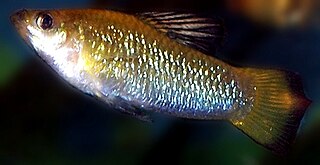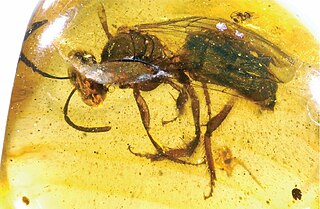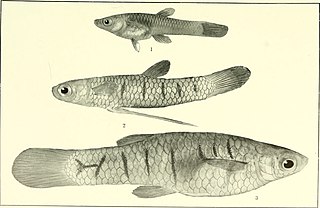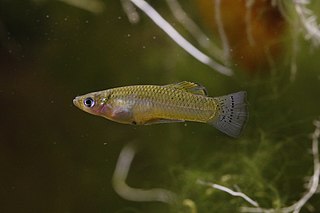
The Poeciliidae are a family of freshwater fishes of the order Cyprinodontiformes, the tooth-carps, and include well-known live-bearing aquarium fish, such as the guppy, molly, platy, and swordtail. The original distribution of the family was the Southeastern United States to north of Río de la Plata, Argentina, and Africa, including Madagascar. Due to release of aquarium specimens and the widespread use of species of the genera Poecilia and Gambusia for mosquito control, though, poeciliids can today be found in all tropical and subtropical areas of the world. In addition, Poecilia and Gambusia specimens have been identified in hot springs pools as far north as Banff, Alberta.

Poecilia is a genus of fishes in the family Poeciliidae of the order Cyprinodontiformes. These livebearers are native to fresh, brackish and salt water in the Americas, and some species in the genus are euryhaline. A few have adapted to living in waters that contain high levels of toxic hydrogen sulfide and a population of P. mexicana lives in caves.

Étang Saumâtre is the largest lake in Haiti and the second largest lake in the Dominican Republic and Hispaniola, after Lake Enriquillo. It is also known as Lake Azuéi ; its Taíno name was Yainagua.

Lake Enriquillo is a hypersaline lake in the Dominican Republic located in the southwestern region of the country. Its waters are shared between the provinces of Bahoruco and Independencia, the latter of which borders Haiti. Lake Enriquillo is the largest lake in both the Dominican Republic and Hispaniola, as well as the entire Caribbean. It is also the lowest point for an island country.

Nesophontes, sometimes called West Indies shrews, is the sole genus of the extinct, monotypic mammal family Nesophontidae in the order Eulipotyphla. These animals were small insectivores, about 5 to 15 cm long, with a long slender snout and head and a long tail. They were endemic to the Greater Antilles, in Cuba, Hispaniola, Puerto Rico, the United States Virgin Islands, and the Cayman Islands.

Limia is a genus of livebearing fishes belonging to the Cyprinodontiform family Poeciliidae, which includes other livebearers such as platys, swordtails, guppies and mollies. They are found in fresh and brackish water. Of the 21 described Limia species, 17 are endemic to Hispaniola, one is found on both Hispaniola and Jamaica, and the Cayman Islands, Cuba, and Venezuela have an endemic species each. Limia are popular in aquaria among more advanced hobbyists.

Lake Miragoâne is a lake in Haiti, located one kilometer southeast of the city of Miragoâne. It is one of the largest natural freshwater lakes in the Caribbean. The lake is 12 km (7.5 mi) long and 25 km² (9.7 mi²) in area.
The San Marcos gambusia is an extinct species of gambusia from the family Poeciliidae that was found only in the San Marcos Springs of Central Texas. The fish has not been seen since 1983. The specific name of this fish honors the American ichthyologist George S. Myers (1905-1985).

Perugia's limia is a small fish of the family Poeciliidae endemic to the Caribbean island of Hispaniola, where it occurs in streams.

Micropoecilia is a genus of poeciliids native to fresh and brackish water from the Amazon Basin to Trinidad. While recognized as valid by FishBase, others have considered this genus as being synonymous with Poecilia.
Gambusia dominicensis, known as the Dominican gambusia, domingo gambusia, or domingo mosquito fish, is a species of freshwater fish native to the lake of Etang Saumatre on Hispaniola, in eastern Haiti and the western Dominican Republic. A 2020 update to the IUCN Red List removed the Dominican Republic from the extent of occurrence description; the range map continues to include both countries. The authors noted, "Extent of Occurrence (EOO) and Area of Occupancy (AOO) cannot be determined with accuracy, as the species has not been collected since 1913 and georeferenced records associated with the type locality are lacking".

Oligochlora is an extinct genus of sweat bee in the Halictidae subfamily Halictinae. The genus currently contains six species, all of which are known from the early Miocene Burdigalian stage Dominican amber deposits on the island of Hispaniola.
Protosialis casca is an extinct species of alderfly in the Sialidae subfamily Sialinae. The species is solely known from the early Miocene, Burdigalian stage, Dominican amber deposits on the island of Hispaniola. Protosialis casca is one of only two known alderfly species present in the West Indies, the only other species is the living Protosialis bifasciata native to Cuba.

Alfaro is a genus of poeciliid fishes endemic to Central America. The generic name honours the Costa Rican archaeologist, geologist, ethnologist, zoologist and Director of the National Museum of Costa Rica, Anastasio Alfaro (1865-1951).

The pike topminnow, also known as the top minnow, is a species of poeciliid found from Mexico to Costa Rica. It has also been introduced to Florida, USA. The female of the species grows to a total length of 20 cm (7.9 in), with males growing to 10 cm (3.9 in). It is the only known member of its genus. Unlike most poeciliids, this is a highly specialized predator, with an extremely flexible upper jaw that enables it to take very large prey items for its size. The pike topminnow was described in 1860 by Austrian ichthyologist Rudolf Kner, who gave the type locality as Belize, which is reflected in this species' specific name.
Hylopanchax is a genus of poeciliids native to the Congo River Basin and Ivindo River in Middle Africa.

Pamphorichthys is a genus of poeciliids native to the Amazon, Paraguay, São Francisco and Itapicuru basins in South America.

The Hispaniola pupfish is a fish endemic to the lakes of Etang Saumâtre and Lake Enriquillo on the island of Hispaniola, in both Haiti and the Dominican Republic.

The Hispaniolan gambusia is a fish endemic to the island of Hispaniola.

Limia sulphurophila, also known as sulphur limia, is a livebearing fish in the family Poeciliidae. It is endemic to the Dominican Republic in the island of Hispaniola.















